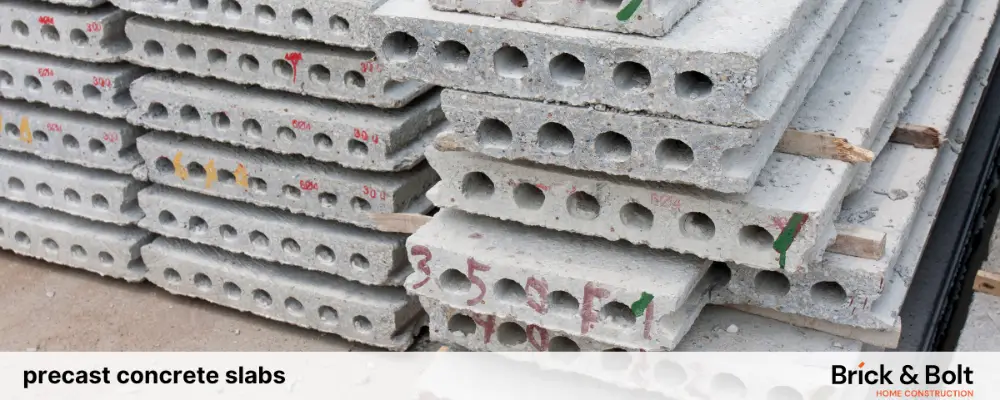Concrete is a versatile building material that can be widely used across the construction industry. The demands of the modern construction industry are increasing day by day. New technological innovations have increased the development of concrete building materials.
To meet the demand of the construction market, precast concrete slabs are made. Most construction professionals prefer precast concrete slabs for easy usage, durability, and strength. Let us explore the advantages, applications, and disadvantages of precast concrete slabs in detail.
What are Precast Concrete Slabs?
Precast concrete slabs are concrete elements manufactured at a factory or plant other than a construction site. They are known for their numerous benefits and extensive application across the construction industry. They are manufactured according to the consumer’s needs in a factory and directly transferred to the construction site for installation.
These can also withstand hard weather conditions and are environment-friendly. It reduces the timeline of the construction process and ensures superior quality, durability, and longevity of the product. It can be customised according to the consumer’s needs and guarantees easy transportation.
Types of Precast Concrete Slabs
Precast concrete slabs are made by pouring the concrete mixture into mould at the factory. The major 5 types of precast concrete slabs that are used in the construction industry are as follows:
- Hollow core units
Hollow core units are also known as voided slabs. They have tubular, circular or other irregularly shaped voids along the entire slab length. These slabs are used in constructing multi-story buildings. They are lighter than regular concrete slabs but equal in thickness and strength. The standard width of hollow core slabs is 120 cm and its thickness varies from 15 cm to 50 cm.
- Single tee units
Single tee units have a deck surface along with longitudinal supporting beams shaped like a Tee. The standard thickness of the deck may vary from 1.5 to 2 inches. The thickness of the concrete beam is 8 inches and its height is around 24 inches.
- Double tee units
Double tee units are suitable for longer spans which require greater support capacity. The standard width of double tee units is 2400 mm and depth varies between 250 mm and 1000 mm. It supports longer spans over 16 m.
- Solid concrete units
It is made of reinforced concrete that has a completely solid and rectangular cross-section. They can be manufactured with prestressed strands that are embedded within the element. They are ideal for constructing residential or commercial buildings that require high load-bearing capacity, fire resistance, and good thermal insulation. The standard thickness of these plates is 200mm. However, these are the heaviest types of precast slabs.
Applications of Precast Concrete Slabs
Precast concrete slabs are widely used in the construction industry with various applications. They are as follows:
- Flooring system
Precast concrete slabs are used in flooring systems for buildings and structures because of their solid strength.
- Bridge decking
Bridge constructions can be efficiently executed with the application of precast concrete slabs. These bridge deck elements are best for their longevity and sustainability.
- Sound barriers
Precast concrete slabs are used in highways and roads for their noise-controlling property, which ensures road safety.
Advantages of precast concrete slabs:
- The construction time of the project is reduced drastically due to its on-time availability.
- Labour cost reduction in the construction site.
- They are generally superior-quality products with zero defective material.
- Precast slabs can be fabricated in various shapes, sizes, and textures according to the consumer’s requirements.
- Precast concrete slabs are valued for their durability and sustainability, as they help reduce waste and minimise energy consumption during production.
- Precast concrete slabs have excellent fire resistance properties which can withstand high temperatures.
- They offer good sound insulation and can resist sounds or noise from external factors. It can also create privacy for occupants.
Disadvantages of precast concrete slabs:
- Some slabs require detailed attention to make and require additional costs for the manufacturing process.
- Transportation charges may be high due to large weight of the slabs.
- They must be handled with the utmost care to ensure proper installation with no gaps and cracks, requiring skilled labour.
- Once it is built, it can’t be remodelled. The designs and requirements have to be mentioned clearly before starting the manufacturing process.
- Improper installation may cause a serious issue. The connectors, bolts, and sealants must be properly fixed to acquire the required strength and ensure stability.
Installation Process for Precast Concrete Slabs
- Panel placement and alignment: Make sure that panels are positioned in the right place as specified in the design and aligned perfectly with the adjacent panels for a solid connection.
- Connection and anchorage methods: To create a long-lasting connection between the panels, connectors, bolts, and sealants are used.
- Quality and inspection checks: Frequent quality checks are required to check whether the panels are connected properly and meet required quality standards. The inspection process must include checking for defects, cracks, and damage that can occur during the installation process.
Conclusion
On the whole, precast concrete slabs are essential in building modern infrastructure. They play a vital role by acting as building materials that are readily available in the market. Precast concrete slabs have high potential growth and development in the future construction industry. They will be more exciting and promising in the upcoming years.
FAQs
The average thickness of the precast slabs ranges from 100mm to 270mm.

